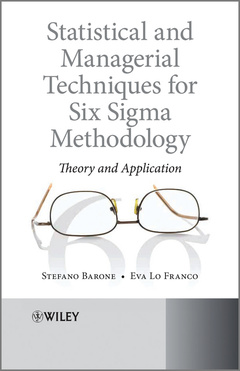Description
Statistical and managerial techniques for Six Sigma methodology: theory and application
Theory and Application
Authors: Barone Stefano, Franco Eva Lo
Language: English
Keywords
palermo; technology; methodology; business; output; management; process; six; quality; strategy; sigma; application; book; tools; statistical; reader; aspects; field; variation; organizational
Approximative price 89.78 €
In Print (Delivery period: 12 days).
Add to cart288 p. · 17.5x25.2 cm · Hardback
Description
/li>Contents
/li>Biography
/li>
Key features:
- Presents both statistical and managerial aspects of Six Sigma, covering both basic and more advanced statistical techniques.
- Provides clear examples and case studies to illustrate the concepts and methodologies used in Six Sigma.
- Written by experienced authors in the field.
The textbook is ideal for graduates studying Six Sigma for Black Belt and Green Belt qualifications as well as for engineering and quality management courses. Business consultants and consultancy firms implementing Six Sigma will also benefit from this book.
1.1 Management by Process
1.1.1 The Concept of ‛,Process'
1.1.2 Managing by Process
1.1.3 The Process Performance Triangle
1.1.4 Customer Satisfaction
1.1.5 The Success of Enterprise
1.1.6 Innovation and Six Sigma
1.2 Meanings and Origins of Six Sigma
1.2.1 Variation in Products and Processes
1.2.2 Meaning of 'Six Sigma'
1.2.3 Six Sigma Process
1.2.4 Origins of Six Sigma
1.2.5 Six Sigma: Some Definitions
13 Six Sigma Projects
1.3.1 Why Implement Six Sigma Projects?
1.3.2 Six Sigma Paths
1.4 The DMARIC Path
1.4.1 Human Resources and Training
References
2Basic Managerial Techniques
2.1 For Brainstorming
2.1.1 Cause-Effect Diagram
2.1.2 Affinity Diagram (KJ Analysis)
2.2 To Manage the Project
2.2.1 Work Breakdown Structure
2.2.2 Gantt Chart
2.3 To Describe and Understand the Processes
2.3.1 The SIPOC Scheme
2.3.2 The Flow Chart
2.3.3 The ServQual Model
2.4 To Direct the Improvement
2.4.1 The Kano Model
References
3 Basic Statistical Techniques
3.1 To Explore Data
3.1.1 Fundamental Concepts and Phases of the Exploratory Data Analysis
3.1.2 Empirical Frequency Distribution of a Numerical Variable
3.1.3 Analysis by Stratification
3.1.4 Other Graphical Representations
3.2 To Define and Calculate the Uncertainty
3.2.1 Definitions of Probability
3.2.2 Events and Probabilities in the Venn Diagram
3.2.3 Probability Calculation Rules
3.2.4 Dispositions, Permutations and Combinations
3.3 To Model the Random Variability
3.3.1 Definition of Random Variable
3.3.2 Probability Distribution Function
3.3.3 Probability Mass Function for Discrete Random Variables
3.3.4 Probability Density Function for Continuous Variables
3.3.5 Mean and Variance of a Random Variable
3.3.6 Principal Models of Random Variables
3.4 To Draw Conclusions from Observed Data
3.4.1 The Inferential Process
3.4.2 Sampling and Samples
3.4.3 Adopting a Probability Distribution Model by Graphical Analysis of the Sample (Probability Plot)
3.4.4 Point Estimation of the Parameters of a Gaussian Population
3.4.5 Interval Estimation
3.4.6 Hypothesis Testing
References
4 Advanced Managerial Techniques
4.1 To Describe Processes
4.1.1 IDEF 0
4.2 To Manage a Project
4.2.1 Project Evaluation and Review Technique
4.2.2 Critical Path Method
4.3 To Analyse Faults
4.3.1 Failure Mode and Effect Analysis
4.3.2 Fault Tree Analysis
4.4 To Make Decisions
4.4.1 Analytic Hierarchy Process
4.4.2 Response Latency Model
4.4.3 Quality Function Deployment
References
5 Advanced Statistical Techniques to Study the Relationships between Variables
5.1 To Study the Relationships between Variables
5.1.1Linear Regression Analysis
5.1.2Logistic Regression Models
5.1.3Introduction to Multivariate Statistics
5.2 To Monitor and Keep Processes under Control
5.2.1Process Capability
5.2.2Online Process Control and Main Control Charts
5.2.3Offline Process Control
5.3 To Improve Products, Services and Production Processes
5.3.1Robustness Thinking
5.3.2Variation Mode and Effect...
Stefano Barone, Assistant Professor at University of Palermo, Italy and Associate Professor at Chalmers University of Technology, Sweden.
Eva Lo Franco, Assistant Researcher at the University of Palermo, Italy.




